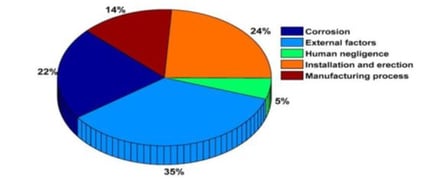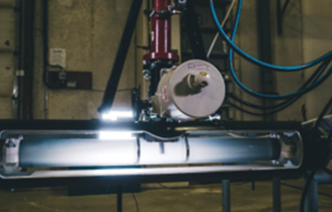Chemical Injection
Chemical injection is required in a wide range of applications and industries including oil pipelines, gas processing, water, and wastewater as well as mining. A chemical injection system is comprised of equipment which injects chemicals into the system at a specific pressure for the system application and provides chemical dosing to avoid process line failures. The process may operate intermittently or continuously in both upstream or downstream systems and is used in corrosion prevention, well cleaning, pipeline flow enhancement and oil recovery.
Pipeline Failure
Impacts of a single oil pipeline failure can be devastating to the environment and incredibly expensive for the companies transporting the product. Pipeline accidents in the U.S. have cost nearly $7 billion and killed or injured over 1,000 people.
While the growth of using pipelines to transport product has been steadily growing, failure rates have remained relatively constant. This gives a unique opportunity for new technology to further reduce failure rates per mile of pipeline. Failures can come from a diverse set of factors as shown in the graph below.
 Chemical Injection Quills
Chemical Injection Quills
The primary component of performing chemical injection is a quill. It is the interface equipment between the chemical feed line and the process pipeline. Chemical injection quills ensure that chemicals are evenly dispersed into the center of the pipeline, which prevents channeling of the chemical down the pipe wall. The injected chemicals are dispersed into the process pipeline by the quill and regulated to accomplish a chemical reaction. This chemical reaction allows for the injection of DRA agents (drag-reducing agents) into the pipeline flow without interfering in the process of cleaning or “pigging” the line.
Injection quills are retractable permitting them to be inserted or removed even when the system is under pressure. This is a valuable benefit when working with chemicals such as ammonia, sodium hypochlorite, and polymers which are all prone to clogging. However, most retractable injection quills are static and must be operated manually, where field technicians have to physically insert and retract the quill. And with injection quills placed every 5 to 6 miles (8 to 10 km), this is obviously a time, labor and cost consuming job.
Hydraulically Operated Retractable Injection Quills
To ensure accuracy, and save time, labor, and money, there have been recent developments in technology to make chemical injection quills that operate hydraulically. A fully automated retractable quill which is engineered to function at full system pressures incorporates remote connectivity options, providing owners and operators with the safest and most efficient method possible to control and regulate their systems. Automated retractable injection quills assist in both decreasing the carbon footprint and increasing productivity by reducing down-time and eliminating the need for constant on-site maintenance and repair.
Standard injection quills need to be removed and replaced before a pipeline can be pigged, this introduces the possibility of human error and incorrect chemical injection quill installation during regular pipeline maintenance. Conversely, a hydraulically operated injection quill is automatically inserted and removed while maintaining a positive seal to the pipeline. This is a significant benefit considering crude oil pipelines usually require pigging on a monthly basis.
Reducing environmental impacts of pipelines requires safe and functionable maintenance. Regular cleaning of a pipeline reduces corrosion and helps protect the environment. Ensuring that quills can be safely injected and removed from a pipeline is key to preventative maintenance.

Hydraulically operated retractable injection quill being tested by the Saskatchewan Research Council
Case Study:
A standard static quill was not monitored, its location forgotten and was struck by a pig running through the pipe after the quill was left hanging in a section of pipeline. The quill was bent up to the bore of the pipe, though fortunately no part of the quill was broken off into the pipeline. Once the problem and its location were finally identified a specialized tool was required to slowly pull the quill out allowing it to bend back. This is a perfect example of human error, where an overlooked quill caused major downtime and considerable cost while a solution was discovered. The issue could have also caused the pipeline to fail and oil to spill into the environment.
In this scenario a hydraulic retractable injection quill with a built-in recovery system would have avoided the problem. In the case where a static quill fails to retract an automated quill can be extracted, allowing it to bend itself back into a straight position until it clears the double block and bleed valve.
Benefits Of Automated Retractable Injection Quills
It’s first important to note that proper chemical injection quill installation is critical. Secondly standard injection quills must be manually removed from a pipeline to perform maintenance, inspection, and replacement of parts. They also need to be removed prior to “pigging” a pipeline. However, there are many benefits to automated injection quills.

Pneumatic & Servo-Driven Injection Quills
Some retractable injection quills can be automated via a pneumatic drive system which allows for the quill to be remotely operated with an air compressor.
In an alternate variation, the quill has a servo drive system, rather than hydraulic or pneumatic. A servo drive can be used in many applications and is highly advantageous if the quill needs to operate at low temperatures [below -31°F (-35°C)] where normally a hydraulic drive would tend to be “sluggish”.
Additional Benefits of Fully Automated Retractable Injection Quills
- Automated retractable injection quills are specifically engineered to function at full system pressures and without shutting down process lines, providing a significant return on investment. Their unique design allows “pigging” to be completed without fluid transfer into the valve system or potential debris damaging the quills.
- Position sensors can be added to track the position of the quill in its stroke, allowing it to accurately extend to a predetermined distance in the pipeline. This provides valuable information that assists with remote operation.
- The tip materials of these quills are selected with a high emphasis on corrosion protection. Depending on the application, the material of the quill can be either 316 stainless steel or zinc plated carbon steel to withstand highly corrosive and abrasive applications.
Conclusion
Injection quills are used to introduce medium to high corrosive chemicals into a pipeline without damage to the pipe wall or side port at the injection point in the pipe. They are used to ensure a uniform and rapid dispersal of injection chemicals into the center stream of a process pipeline in order to avoid corrosive liquids from clinging to the side of the pipe. Standard injection quills must be manually removed from a pipeline to perform maintenance and other functions. This, along with proper chemical injection quill installation after maintenance, is very time and labor intensive.
With four to five injection quills being mounted every 25 miles (40 km) of pipeline it is in the interest of environmental safety and cost control to ensure potential leak points are as secure as possible. With fully automated retractable quills operators never need to remove the main sealing port after installing, the security of this positive seal is sustained for a much longer period than standard injection quills.
In addition, an automated retractable injection quill is used to function at full system pressure and has remote connectivity options, providing owners and operators with the safest method possible to control and regulate their systems.
Sources Include:

